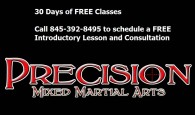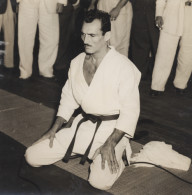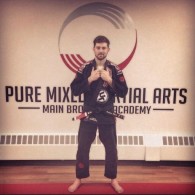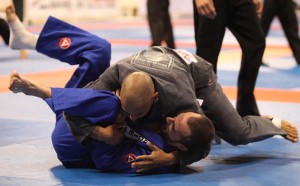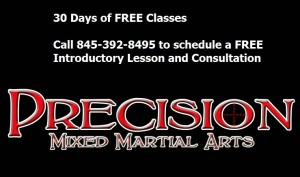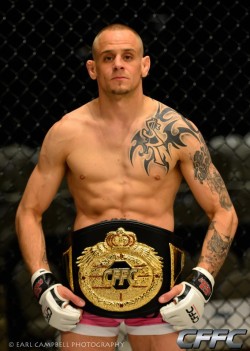I used to be pretty good! If you like grunge music and double legs train with me at my Poughkeepsie MMA gym Precision MMA in LaGrange, NY visit www.poughkeepsimixedmartialarts.com
The #1 Mistake Entry Level MMA Fighters Make
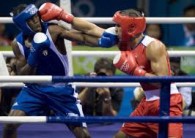 Competition is anxiety producing. Each athlete has to discover their unique coping mechanism that allows them to perform at their best despite the stress of the event. Regardless of how rigorous the training environment may be, this is not a solution that is found within the walls of the gym. No, this skill is only acquired through the exposure of standing across from a someone you know is going to do everything in their power to beat you. It is all but undeniable that wrestlers make the smoothest transition to professional MMA competition. However, I do not believe this is because wrestling is the best base skill for mixed martial arts. The vast majority of techniques from wrestling do not translate to MMA and many wrestling habits will get you destroyed when faced with a competent grappler or striker. Also, most of the wrestlers who find success in the cage only do so after adopting a striking or BJJ intensive strategy. Johnny Hendrix is known more for his devastating right hand than his great inside trip. So why then do wrestlers reach such high levels? In my estimation it is because wrestlers endure hundreds of matches in a grueling format of combative competition. Just as amateur boxers have hundreds of bouts before stepping into the professional arena, wrestlers are groomed from an early age to stand across from someone and keep themselves together. I’m sure Ben Askren cried, threw up, had rubber legs, under performed, over trained and mentally quit in many a wrestling match coming up the ranks. Somewhere along the line though he zoned in and found his way to win and that mental fortitude laid the foundation for a successful professional career. For those who dream of wearing UFC gold, delay the gratification of being a pro and enjoy your time as an amateur. Take your loses in stride and find new ways to challenge yourself across as many disciplines as possible.
Competition is anxiety producing. Each athlete has to discover their unique coping mechanism that allows them to perform at their best despite the stress of the event. Regardless of how rigorous the training environment may be, this is not a solution that is found within the walls of the gym. No, this skill is only acquired through the exposure of standing across from a someone you know is going to do everything in their power to beat you. It is all but undeniable that wrestlers make the smoothest transition to professional MMA competition. However, I do not believe this is because wrestling is the best base skill for mixed martial arts. The vast majority of techniques from wrestling do not translate to MMA and many wrestling habits will get you destroyed when faced with a competent grappler or striker. Also, most of the wrestlers who find success in the cage only do so after adopting a striking or BJJ intensive strategy. Johnny Hendrix is known more for his devastating right hand than his great inside trip. So why then do wrestlers reach such high levels? In my estimation it is because wrestlers endure hundreds of matches in a grueling format of combative competition. Just as amateur boxers have hundreds of bouts before stepping into the professional arena, wrestlers are groomed from an early age to stand across from someone and keep themselves together. I’m sure Ben Askren cried, threw up, had rubber legs, under performed, over trained and mentally quit in many a wrestling match coming up the ranks. Somewhere along the line though he zoned in and found his way to win and that mental fortitude laid the foundation for a successful professional career. For those who dream of wearing UFC gold, delay the gratification of being a pro and enjoy your time as an amateur. Take your loses in stride and find new ways to challenge yourself across as many disciplines as possible.
Even more important though, find a good gym to train at, if you’re in the Poughkeepsie area check out Precision MMA in LaGrange, NY and if you find yourself in Morris County, NJ check out Pure Mixed Martial Arts.
Side Mount Escape Series
Learn it or fall victim to it
Andy Main Highlight Video Morris County MMA
In case you read my last blog post about Denville MMA black belt Andy Main and were wondering what his skills looked like in action, you can check out this amazing highlight video showcasing Andy’s BJJ and MMA skills.
Check out more at www.puremixedmartialarts.com
Andy Main – a Pure Martial Artist – Denville MMA
In the sport of mixed martial arts there are two distinct groups of people – fighters and martial artists. To the uninitiated they appear one in the same. Prior to bouts they prepare and perform the same, as a result many do not recognize or appreciate the difference. The distinction is one of motivation and lifestyle. A fighter enters the ring chasing fame, fortune, excitement or glory. A martial artist seeks self-knowledge, physical expression, creativity and truth in combat. They take the ideals of the arts – discipline, courage, wisdom, gentleness and efficiency and internalize them. Training is not seen as an activity or preparation, but a way of life. Take away the money, fame, crowd and cameras and the fighter will go elsewhere, the martial artist will remain. Sadly, at the professional level of MMA the fighters have strength in numbers. When fights aren’t booked the training mats are desolate. Strength and conditioning coaches and nutritionists are given higher esteem than jiu-jitsu and muay thai instructors. Training is seen as a means to an end rather than an end unto itself. Learning the nuances of the art is secondary, winning is king.
Among the sea of combatants stands a notable exception, a pure martial artist – Andy Main. I first met Andy as the quiet teenager who somehow always had a black eye. He wasn’t the strongest or the fastest guy in the room. He didn’t boast any elite credentials or come from an athletic pedigree, but he stood out in his own way. He was the grinder, the guy who showed up to practice the day after a major tournament, the guy who never stayed home no matter how many shots he took the day before. Along with this quiet toughness was a thirst for knowledge. While most on the fight team barely knew how to tie their belt he was a staple at every gi class. He became an unpredictable striker learning to fight from both stances and learning Judo to break out of the typical wrestler mold.
Andy began racking up victories making a name for himself at a blitzkrieg pace. At just 21 years old he became one of the youngest cast members of The Ultimate Fighter. While his dedication paid high dividends his grueling pace took a toll on his body. His bright fire was extinguished after a bout of shingles, mono, flu and every other ailment known to man. He was sidelined from competition for two years, at the time he didn’t know if he’d ever fight again.
While he was forced to tone his training schedule back he maintained his martial arts lifestyle. Learning as much as he could; working his mind when his body wouldn’t cooperate. Helping his teammates prepare for their bouts he discovered his love for teaching.
Fast forward and Andy’s endurance has paid off. He’s riding a 4 fight unbeaten streak that includes battles against some of Japan’s top competitors. He’s teamed up with his brother to open the top Denville MMA gym and is now spreading the martial arts lifestyle to people across Morris County.
As a student Andy has been willing to do what others could not or would not. He made the 90 minute drive to train at my gym. He’d seek out the top minds in the sport for seminars and training camps. He’d put his ego aside and commit to training outside his comfort zone day in and day out.
So it was with great pride that I stood alongside his fellow instructors Jamey Cruz and Yanni Hronakis as his black belt was tied around his waist.
Train with Andy at his Denville MMA gym Pure MMA Free for 14 days call 973-784-3777 or visit www.puremixedmartialarts.com
The Mighty Miller
While I was out at UFC 172 Bloody Elbow profiled Jim Miller’s training for his bout with Yancy Medeiros
Check it out HERE
The Strike Based Jiu-jitsu of Javier Vazquez
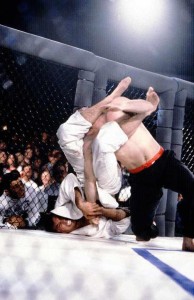 Why did you start jiu-jitsu? Additionally, ask yourself why you chose jiu-jitsu over the myriad of other martial arts available. For me the answer was simple, I needed to learn how to fight. I remember being a skinny freshman in high school when the captain of the varsity football team, a pharmaceutically enhanced goliath, laughed as he threw his trash at me during lunch. In a moment of anger I threw it back in his face as hard as I could along with a few four letter words for good measure. Not wanting to lose his alpha status he got nose to nose and put the fear of God in me. I didn’t back down and I put on my game face, but (aside from the time I was attacked by a pitbull) it was the single scariest moment of my life. Fortunately I made it through the encounter unscathed, but the feeling of helplessness had staying power. I never wanted to feel that way again, this was a problem that needed solving. I wanted to learn, but I thought most martial arts didn’t work for a real fight against a bigger opponent. I had no idea where to start, after doing some research I thought “Jeet Kune Do” would be my best bet since it touted itself as a no BS, no rules fighting style. I called a gym that advertised JKD classes, the receptionist told me the instructor had left, but encouraged me to try Brazilian Jiu-jitsu instead. I was skeptical, but they told me to check out the first few UFCs and see it in action. I had heard about the UFC on Dateline specials and they always referenced “The World’s Most Dangerous Man” Ken Shamrock. When I saw skinny Royce Gracie effortlessly dispatch of Shamrock and in subsequent events dispose of the similarly terrifying Dan Severn and Kimo I knew Brazilian Jiu-jitsu was for me. I immediately set an appointment. At my first class I had every extremity wrenched and was repeatedly strangled by a woman who was too small to ride most roller coasters. While some might have found this discouraging, I was elated. Brazilian Jiu-Jitsu was EXACTLY what I was looking for.
Why did you start jiu-jitsu? Additionally, ask yourself why you chose jiu-jitsu over the myriad of other martial arts available. For me the answer was simple, I needed to learn how to fight. I remember being a skinny freshman in high school when the captain of the varsity football team, a pharmaceutically enhanced goliath, laughed as he threw his trash at me during lunch. In a moment of anger I threw it back in his face as hard as I could along with a few four letter words for good measure. Not wanting to lose his alpha status he got nose to nose and put the fear of God in me. I didn’t back down and I put on my game face, but (aside from the time I was attacked by a pitbull) it was the single scariest moment of my life. Fortunately I made it through the encounter unscathed, but the feeling of helplessness had staying power. I never wanted to feel that way again, this was a problem that needed solving. I wanted to learn, but I thought most martial arts didn’t work for a real fight against a bigger opponent. I had no idea where to start, after doing some research I thought “Jeet Kune Do” would be my best bet since it touted itself as a no BS, no rules fighting style. I called a gym that advertised JKD classes, the receptionist told me the instructor had left, but encouraged me to try Brazilian Jiu-jitsu instead. I was skeptical, but they told me to check out the first few UFCs and see it in action. I had heard about the UFC on Dateline specials and they always referenced “The World’s Most Dangerous Man” Ken Shamrock. When I saw skinny Royce Gracie effortlessly dispatch of Shamrock and in subsequent events dispose of the similarly terrifying Dan Severn and Kimo I knew Brazilian Jiu-jitsu was for me. I immediately set an appointment. At my first class I had every extremity wrenched and was repeatedly strangled by a woman who was too small to ride most roller coasters. While some might have found this discouraging, I was elated. Brazilian Jiu-Jitsu was EXACTLY what I was looking for.
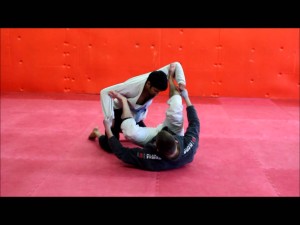 My story is not unique, almost everyone who started when I did saw UFC 1 and wanted Royce Gracie’s super power. Jiu-jitsu was about empowerment, personal protection and real fighting. However, the more I trained the more my techniques drifted from “vale tudo” to grappling specific. My spider guard was improving, but my ground and pound defense was non-existent. I decided to take matters into my own hands. I’d ask neighborhood kids to punch me while I tried to take them down. I got a key to the gym and met up with one of the guys and started rolling with slaps. I watched every MMA event I could and tried to mimic the strategies that seemed effective. I learned by trial and error. I endured a few headaches and black eyes, but I quickly came to understand the most important element of BJJ for fighting – always control the distance.
My story is not unique, almost everyone who started when I did saw UFC 1 and wanted Royce Gracie’s super power. Jiu-jitsu was about empowerment, personal protection and real fighting. However, the more I trained the more my techniques drifted from “vale tudo” to grappling specific. My spider guard was improving, but my ground and pound defense was non-existent. I decided to take matters into my own hands. I’d ask neighborhood kids to punch me while I tried to take them down. I got a key to the gym and met up with one of the guys and started rolling with slaps. I watched every MMA event I could and tried to mimic the strategies that seemed effective. I learned by trial and error. I endured a few headaches and black eyes, but I quickly came to understand the most important element of BJJ for fighting – always control the distance.
My technique improved, but it was still terribly unrefined. I would get a tip here and there and bought a few Mario Sperry vale 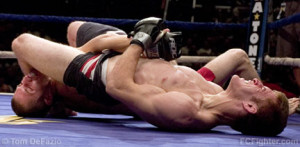 tudo videos, but I didn’t have a real strategy beyond get really close and try to submit them fast as you can. I was basically winging it. The instruction I was getting in BJJ class was quality grappling advice, but it was always up to me to modify it to prevent strikes. My coaches weren’t overly concerned with the finer points, even once I started my professional MMA career the idea was basically “just take them down and play your game”.
tudo videos, but I didn’t have a real strategy beyond get really close and try to submit them fast as you can. I was basically winging it. The instruction I was getting in BJJ class was quality grappling advice, but it was always up to me to modify it to prevent strikes. My coaches weren’t overly concerned with the finer points, even once I started my professional MMA career the idea was basically “just take them down and play your game”.
Shockingly, this strategy was fairly successful.
I was winning fights quickly, but once my blitzkrieg submission attack fell short I started taking damage. Even when I won, hospital visits were becoming a post-fight tradition for me. I knew I needed to improve the defensive side of my ground attack. I had a million ways to tap someone out, but very few to stop them from bashing my brains in. I needed a new style, a new approach.
Believe it or not I won this fight
I saw that style in action one night while watching the old WEC. The fight was Chad Mendes vs Javier Vazquez. I was always a big fan of Javier from his days on the grappling circuit. I was rooting for him, but honestly I thought he was going to get crushed. Mendes was undefeated, a stellar athlete and he was 8 years younger and had taken no real damage in his career. The fight started and Chad put Javi right to his back. I thought to myself “if Javi doesn’t sub his quick he’s going to take a beating from this position”. However, that was not the case. Javi’s guard completely neutralized Mendes. He patiently threw up submission attempts with no forced urgency. He looked completely comfortable on bottom and was confident he wouldn’t take damage. Although the judges didn’t agree I thought he won the round off his back. Javi ended up losing the decision, but I knew his style of BJJ for MMA was something I wanted to emulate.
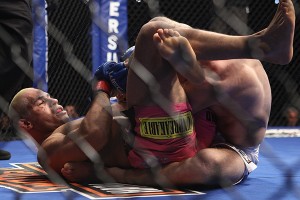 Fast forwarding, I heard Javi on a podcast talking about his style of grappling termed “strike based jiu-jitsu”. The idea was that all the techniques he taught from all positions assumed the partner would be striking. Additionally, the focus was safety first offense second. I realized this was exactly what I was looking for, a BJJ system that needed no modifications for real fighting, taught by someone who had been tested at the highest level of combat sports. I made my mind up that I had to check this out. Fortunately, Javi was going to be near my home town for a seminar and through the magic of Facebook I was able to book him at my gym as well.
Fast forwarding, I heard Javi on a podcast talking about his style of grappling termed “strike based jiu-jitsu”. The idea was that all the techniques he taught from all positions assumed the partner would be striking. Additionally, the focus was safety first offense second. I realized this was exactly what I was looking for, a BJJ system that needed no modifications for real fighting, taught by someone who had been tested at the highest level of combat sports. I made my mind up that I had to check this out. Fortunately, Javi was going to be near my home town for a seminar and through the magic of Facebook I was able to book him at my gym as well.
In addition to the seminar I booked a private lesson so I could get more in depth in the system. The approach was completely revolutionary, but shockingly simple at the same time. We worked from guard and bottom side control. The first thing we broke down was how someone could strike us, then we systematically shut it down by clamping, blocking, pummeling or bridging – movements with which I was already well acquainted. The next step was to simply relax and frustrate the opponent by showing them their dominant position would provide them no openings. The frustration would lead to reaction which would create the opening for escape. I quickly realized this would be equally effective for pure grappling with no modification. Rather than exhausting myself fighting frantically to escape mount or side control I could simply relax knowing that I was perfectly defended. Javi’s game made scary positions much more tolerable. A fundamental principle of his SES (side control escape series) approach was not allowing the partner to control your head. My old coach has a saying “when in doubt smash the head”. Against properly executed SES positioning head smashing is practically impossible. I realized that this would not only change my bottom game, but force me to find new methods of attack from the top and so the journey began.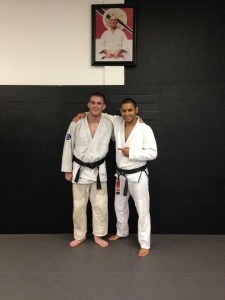 I quickly realized that if I wanted to commit to learning this system I would have to head out to the west coast for some more intensive training sessions. I booked my ticket and flew out to Rancho Cucamonga California to Javier’s gym “Gracie Rancho”. The intensive training helped cement the defensive system and introduce me to the offensive side as well. Javier originally received his black belt under the Carlson Gracie banner, known for its offensive attacking style. However, after meeting his wife Rose Gracie he learned the defensive Helio Gracie self defense system of the Gracie Academy. In many ways Javier is the bridge between the two ideological paradigms of the Gracie system. Javier was always known for his flashy submissions, earning him the moniker “Showtime” – but his system of ground and pound is like nothing I’ve ever seen before. By training the defenses so intimately, Javier knows exactly where to position himself to overcome them and make his opponent helpless against devastating strikes. Unlike MMA fighters Javi wasn’t simply concerned with blows legal under the unified rules of mixed martial arts. His system accounts for variable such as head butts and groin strikes.
I quickly realized that if I wanted to commit to learning this system I would have to head out to the west coast for some more intensive training sessions. I booked my ticket and flew out to Rancho Cucamonga California to Javier’s gym “Gracie Rancho”. The intensive training helped cement the defensive system and introduce me to the offensive side as well. Javier originally received his black belt under the Carlson Gracie banner, known for its offensive attacking style. However, after meeting his wife Rose Gracie he learned the defensive Helio Gracie self defense system of the Gracie Academy. In many ways Javier is the bridge between the two ideological paradigms of the Gracie system. Javier was always known for his flashy submissions, earning him the moniker “Showtime” – but his system of ground and pound is like nothing I’ve ever seen before. By training the defenses so intimately, Javier knows exactly where to position himself to overcome them and make his opponent helpless against devastating strikes. Unlike MMA fighters Javi wasn’t simply concerned with blows legal under the unified rules of mixed martial arts. His system accounts for variable such as head butts and groin strikes.
The thing that impressed me the most about my trips to California though was not Javi’s advanced techniques, but rather his method for teaching beginners. From day 1 all his students leard how to defend against strikes. They don’t spend all their mat time doing triangle chokes and armbars, instead they are clinching against strikes and neutralizing punches on the ground. My method was to get everyone to a blue belt in pure grappling based jiu-jitsu and then start teaching them vale tudo styled techniques. I thought the strikes on the ground would be too much for them to handle and that the extra variables of punches, knees and elbows would overwhelm them. However, I quickly realized that Javi’s white belts had a better understanding of striking defense than most of the purple belts at other academies. As a result I’ve completely reversed my thinking. Now my students start with striking self defense and only learn the more grappling specific BJJ at blue belt. The most dramatic difference in my technique became visible in my MMA sparring. I started noticing everyone was easier to hit when I was on top and easy to stifle when I was on bottom. Half my sparring is done at my home gym and half with a group of pro and amateur MMA fighters far from my home. As I started teaching my students to techniques Javi had taught me I began to notice they were MUCH harder to ground and pound than the pro fighters I’d spar. Despite the fact that this group included high school students, police officers and musicians by implementing strike based jiu-jitsu they had better striking defense than Bellator and Strikeforce veterans. Many of the fighters have since converted and now tag along whenever Javier comes up to my school.
The most dramatic difference in my technique became visible in my MMA sparring. I started noticing everyone was easier to hit when I was on top and easy to stifle when I was on bottom. Half my sparring is done at my home gym and half with a group of pro and amateur MMA fighters far from my home. As I started teaching my students to techniques Javi had taught me I began to notice they were MUCH harder to ground and pound than the pro fighters I’d spar. Despite the fact that this group included high school students, police officers and musicians by implementing strike based jiu-jitsu they had better striking defense than Bellator and Strikeforce veterans. Many of the fighters have since converted and now tag along whenever Javier comes up to my school. 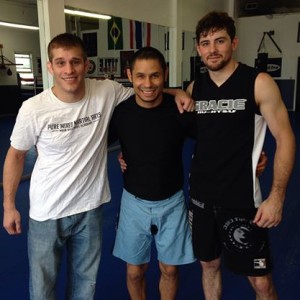
If you live on the east coast and want to join the strike based jiu-jitsu revolution take the trip to my Poughkeepsie MMA school Precision MMA on May 3rd from 1-3pm for Javi’s no-gi seminar. Invest $60 in your personal protection. Email Precisionmma@gmail.com or call 845-392-8495 to reserve your spot.
For you lucky souls living near rancho cucamonga check out Javi’s academy Gracie Rancho
Can’t make the trip? Javi is sharing some of his strike based jiu-jistu via instagram http://instagram.com/javiershowtime#
5 Ways To Take 1st Place at Your Next Brazilian Jiu-Jitsu Tournament
5 Ways to Take 1st Place at Your Next Brazilian Jiu-Jitsu Tournament by Jamey Bazes
Jamey is a life-long martial artist, winner of over 100 competitive matches, and BJJ Brown Belt under Brian McLaughlin.
One of the great things about the sports of Brazilian Jiu-Jitsu and Submission grappling is that since there are a number of ways to score points and a number of legal submissions that can lead to a win it is possible to have many different game plans when competing. While some divisions are fought with the Gi on while others are strictly no-gi, and the point systems and legal techniques can vary from one tournament to the next, in general the same types of dominant positions and takedowns are likely to score points regardless and the majority of submissions are legal across the board. In this article I will discuss 5 different strategies which a grappler can use in grappling and BJJ tournaments to secure victories and take 1st place while citing experiences from some of my past tournament victories and what worked for me.
To add a little bit of personal background, I earned my Brazilian Jiu-Jitsu Brown Belt from Brian McLaughlin of Precision MMA back in 2010, though my actual Jiu-Jitsu journey began back in 1996 with Steve Kardian at Thornwood BJJ. Over the years my grappling style has changed quite a bit but I have certainly been exposed to multiple styles, from more traditional Gi grappling to explosive no-gi submission grappling techniques, wrestling based grappling, 10th Planet BJJ guard tactics, and even a very little bit of Judo and Sambo. After having competed in 33 tournaments under different rules at every belt from White to Brown, every experience level in no-gi and multiple weight classes I have seen first hand which strategies work and do not work in multiple scenarios, not only for myself but for my fellow competitors. As such, I would like to share 5 different formulas I have used and seen others use to successfully medal in different tournaments with the hopes that these can help future competitors to build game plans towards success when it comes time for them to compete.
Tournament strategy number 1: Top Control
No matter what rules one is competing under and whether the division is gi or no-gi, the importance of gaining and maintaining a dominant top position cannot be over emphasized. Though tournament rules and point systems will vary, in general points are scored for either a takedown or a sweep from bottom guard or half guard which results in one achieving a top position. If the competing grappler does score one of these, the worst case scenario is that he will end up on top in his opponent’s guard, and unless his opponent pulled guard to begin with this then that means that the grappler on top will probably start the match up on points. However, unlike wrestling, neither Gi Jiu-Jitsu or no-gi submission grappling matches end once a top position is achieved and some grapplers would prefer to play from bottom guard. With this in mind, it is essential that any top game player have extremely good submission defense and guard passing skills.
As most grapplers know, in the average tournament points will be achieved from passing guard to sidemount, and then more points from progressing to mount or backmount. The “top control” strategy could actually be a misnomer in the sense that it can be several strategies in one, but the common thread is that they all revolve around getting on top and staying on top. In it’s purest form, this would probably be a style where the grappler tries to never allow his back to hit the mat, scoring the takedown right off the bat, and progressing to dominant top positions or a submission from there. This a style that works particularly well for former wrestlers who have excellent takedowns and have also cross trained in BJJ. Since I never wrestled in school this is not my primary style but I have seen it employed quite well by my instructor Brian McLaughlin. In various matches Brian has had over the years I have witnessed him achieve the victory by first scoring the takedown and then passing guard and either winning by points from top control or securing a submission from mount, sidemount or backmount to get the tap.
Top control is a practical style of grappling because it applies not only to Gi and No-Gi grappling but also to Mixed Martial Arts and street fighting. But what if you do not have strong wrestling skills and wish to employ this method one might ask? The answer is simple: one must become good at sweeping from bottom guard or half guard or find ways of ending scrambles on top. This is how I have used this strategy to win some of my past matches. For example, in a no-gi absolute division several years back at the Diamond State Games in Delaware I went up against a very formidable opponent named Seph Smith. Both Smith and I like leg locks so it ended up being a constant battle to see who could secure any number and between the two of us we made attempts for heel hooks, calf splicers, straight knee locks and toe holds from both top and bottom positions. Since neither of us could secure the submission, pass the other’s guard or take the other down, I realized mid-match that if I wanted to win the best way of doing so would be to end every scramble in top guard. At times he’d drop back for a calf splicer and I would escape, or I would drop back for a toehold and he would escape. Either way, when each lock was broken and a scramble for top position ensued I made sure to sit up first and gain top guard. In this way I won this match and advanced to the next round.
Tournament Strategy Number 2: Bottom Guard Player
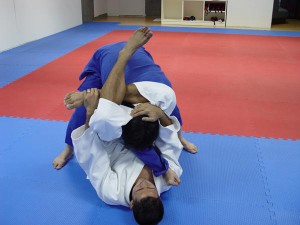
BJJ Submission
Strategy number 2: Bottom Guard Player. As most people well acquainted with BJJ or MMA know, being on the bottom does not necessarily mean one is losing the match or fight. Many submissions or sweeps are possible from bottom guard which can lead to victory. Some instructors would recommend that a grappler not pull guard initially and try to go to the takedown, resorting only to the “bottom guard strategy” if taken down. This is often a good philosophy, though I would argue that guard pulling does have a time and place perhaps if one’s opponent is an amazing wrester who he simply cannot take down but whom he thinks he can easily submit from guard. Regardless, use of an aggressive bottom guard can be a way to achieve 1st place in a tournament and I used this strategy back in 2007 to submit a much larger opponent in the finals of the No-Gi absolute division at Brad Daddis’s South Jersey Grappling Championships. After submitting my first two opponents I found myself up against a wrestler who was much larger than me, probably around 230lbs while I myself was only about 170lbs. He quickly took me down with a double leg which I felt powerless to stop. Once on my back in bottom guard however I waited for him to attempt a double-unders guard pass at which point I transitioned to a triangle choke. Being such a large guy he lost his footing while leaning forward to stack me up and toppled forward allowing me to land in a mounted triangle position. From there I turned and secured the triangle choke while on my side to take home the belt for the absolute division.
Strategy number 3: Stop, Drop and Leglock or Go for the Sub from Standing
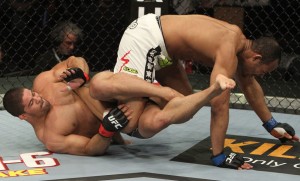
Rousimar Palhares often uses the Stop, Drop, and Leglock Strategy
“Stop, Drop and Leglock” is a term that I coined for a strategy which I have been extremely successful with in tournaments, though I by no means created it. Professional fighters like Masakatsu Imanari and Rousimar Palhares have made this strategy work for them in many high level fights, proving it is not only effective in sub grappling. When it comes to the standup portion of a Brazilian Jiu-Jitsu or Submission Grappling match, most grapplers think that there are really only two options: either go for the takedown or pull guard or half guard. There is, however, a 3rd option, which is to go for the submission from the feet. While most subs will be completed on the ground, many can be attempted from the feet and this very frequently catches the opponent off guard because he does not consider it an option or something he needs to be concerned about. I myself am not particularly good at flying armbars, flying triangles, standing guillotines or standing Kimura-traps, but these are also very effective submissions which can be pulled off from a standing position in either Gi Jiu-Jitsu or no-gi submission grappling. For me, going for leglocks from a standing position has always been very natural and effective. The way that I typically do it is by starting off the match with a little bit of hand fighting and making it look as though I am going to try for a takedown. Once I get close enough and am convinced that the opponent is distracted, I then like to drop to my back, hook the opponents ankle with my arm and spin upside down, wrapping my other leg around my opponent’s straightened leg while he is still standing. From there he will inevitably fall one way or another because I will be pulling his base out from under him. Then I usually transition to any number of leg locks like toeholds, heel hooks or straight kneelocks. If these do not work however, I have found that upper body submissions like triangles or armbars can sometimes be transitioned to or the leg lock can be used as a sweep by letting go and sitting up on top of the opponent. This strategy isn’t only effective because it is unpredictable but also because it forgoes all the other usual positions. If done correctly you don’t have to worry about passing your opponents guard or preventing him from passing yours. Instead, you cut right to the chase and start the submission battle right away. Even better, this strategy often ends the match very quickly, leaving one with extra energy in a tournament for one’s next matches. I used this several years ago to take first place at a no-gi division at the Diamond State Games in Delaware, when I dropped down quickly and secured a tap by way of toehold against a professional Pure MMA fighter.
Strategy number 4: Submission Over Position
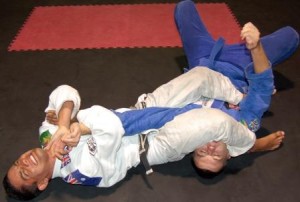
The armbar is a common BJJ submission
In a way, this strategy goes hand in hand with strategy number 3 because when going for a sub from standing you are not generally starting off with a concern over gaining dominant ground position and once you hit the ground you start a submission chain which very frequently leads to the match ending before any static or conventional position is achieved. However, this strategy differs of course in that you can start the match off with a conventional takedown, sweep or guard pull and still take this attitude into the match as it progresses. The general idea here is not being overly concerned with guard passing, achieving or maintaining side mount, mount or back mount, or even being overly concerned with whether or not your opponent passes your guard or gets a dominant top position on you. This is a very “all or nothing” approach as if it fails one usually ends up down on points, but it’s a very pro-active and aggressive way of grappling. I used this strategy to win the opening round of the NAGA Worlds in 2010 in the No-Gi Advanced Welterweight division against Michael Padilla, a well known professional grappler and Amateur MMA fighter. The match started with him shooting a single, which I sprawled on, at which point he off balanced and swept me to bottom half guard. After ending up in full guard he lifted me up off the ground at which point I hooked one his legs and used my typical upside-down leg attack. While trying to secure the leg lock I placed no concern over what position we would end up in if the leg lock failed. I initially tried a toehold and then a straight knee lock, both of which he defended. However, in his haste to employ strategy number 1 and end up in top control and feeling secure in having shut off my lower body attacks he forgot to be wary of upper body submissions and as he tried to sit up in my full guard I switched my hips and sunk in a triangle for the tap, putting me in the finals of that division.
Strategy number 5: Hold Onto That Point
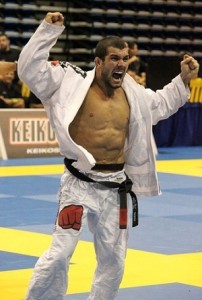 This strategy is seen in many tournaments these days where two evenly matched opponents cannot submit eachother or score large numbers of points so one becomes satisfied with gaining a one point advantage and preventing himself from being scored on to take the win. After winning that first match by triangle in the opening round of the Advanced No-Gi Welterweight division at the NAGA Worlds in 2010, I found myself in the finals against a very skilled 10th Planet Jiu-Jitsu Purple Belt and this was the strategy that I used. At the beginning of the match he pulled guard and I went for a heel hook. NAGA awards points for strong submission attempts so I was given one point for this. Following this, not much happened in this match. He spent some time in my guard trying to pass which he could not do, but neither could I secure a sub or a sweep. Eventually, we found ourselves back on our feet and not being a wrestler he was wary to go for a takedown on me. I was also wary to go for one on him because I thought it might leave me open to a guillotine attempt, and being up by one point I knew the onus was on him to score. As the match winded down he shot for a double leg takedown which I sprawled on. I then pulled guard and controlled him for the remaining seconds to win the division and take home the belt. It was a conservative win, but it worked, and though less than exciting to watch this strategy consistently works for many top grapplers when all else fails.
This strategy is seen in many tournaments these days where two evenly matched opponents cannot submit eachother or score large numbers of points so one becomes satisfied with gaining a one point advantage and preventing himself from being scored on to take the win. After winning that first match by triangle in the opening round of the Advanced No-Gi Welterweight division at the NAGA Worlds in 2010, I found myself in the finals against a very skilled 10th Planet Jiu-Jitsu Purple Belt and this was the strategy that I used. At the beginning of the match he pulled guard and I went for a heel hook. NAGA awards points for strong submission attempts so I was given one point for this. Following this, not much happened in this match. He spent some time in my guard trying to pass which he could not do, but neither could I secure a sub or a sweep. Eventually, we found ourselves back on our feet and not being a wrestler he was wary to go for a takedown on me. I was also wary to go for one on him because I thought it might leave me open to a guillotine attempt, and being up by one point I knew the onus was on him to score. As the match winded down he shot for a double leg takedown which I sprawled on. I then pulled guard and controlled him for the remaining seconds to win the division and take home the belt. It was a conservative win, but it worked, and though less than exciting to watch this strategy consistently works for many top grapplers when all else fails.
These 5 strategies are battle tested and all equally capable of leading a grappler to a win under any tournament format. It is important to know how to use each one as opponents’ styles will vary and one method alone will not always lead to victory. Next time you have an upcoming grappling tournament consider which of these you may want to use and be prepared to use each if your primary strategy does not work out the way you had planned.
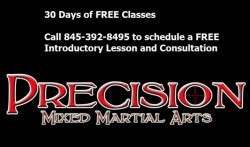
Poughkeepsie BJJ
Train with Jamey at Precision Mixed Martial Arts in Lagrangeville, NY and get the best Poughkeepsie BJJ training available. Classes 7 days a week. Call us at 845-392-8495 or click here to learn more. Make sure to ask about our 30 Day FREE Trial.
“I can’t let you get close” – Chael Sonnen knows the golden rule of street fighting.

The recent on set brawl between Chael Sonnen and Wanderlie Silva during The Ultimate Fighter Brazil highlighted an essential lesson that every Brazilian Jiu-Jitsu practitioner should keep in mind when things start to get out of hand – control the distance. As tensions began to rise between the pugilists Chael attempted to deescalate the situation politely asking Wanderlie to please stop. Once Chael realizes that diplomacy has failed he shoves Wanderlie away saying “I can’t let you get close”. This statement served two purposes; first it told Wanderlie that his shove was an act of personal protection and not aggression. He wasn’t trying to insight him only keep safe. Secondly, it put him at a comfortable distance too far to be struck. Jiu-jitsu fighters are often trained to clinch, but they forget that being at a distance is often times the safer option since it allows for potential flight. Additionally, it is easer to clinch on an opponent who is coming towards you rather than one retreating away. Once you create the distance a motivated attacker must advance if they want to pursue the attack further. Chael drew Wanderlie in with the full intention of closing the distance once Wanderlie initiated a committed motion. A striking attacker wants their opponent in the mid range, right at the end of their punches placing them close enough to hit, but far enough to generate power. Chael’s role as the grappler was played perfect. Keeping the hands up and chin protected he goes from being too far to immediately too close, executing a double leg while in flip flops is perhaps even more impressive.
The sad reality is that this concept of distance management is being lost by many modern day BJJ practitioners. The sportive game, while technically advanced, is often played completely at the mid range. The same rules that apply on the feet exist on the ground, especially from the guard. If someone is in the mid range either kick them away and stand up in base or you pull them in so tight they don’t have an inch of daylight. The “self defense problem” is not that people are training exotic techniques or positions, but rather that they are executing them from the inappropriate distance.
Looking for a Poughkeepsie MMA school that teaches realistic self defense? Visit Precision MMA and take a 30 Day free trial call 845-392-8495 or visit http://www.bjjfighter.com
Sean “Shorty Rock” Santella gets some press
Shorty has been the best flyweight outside the UFC for a while now, hopefully he’ll get his call up soon
http://rankingmma.com/10-best-mma-flyweight-prospects-2014/10/


